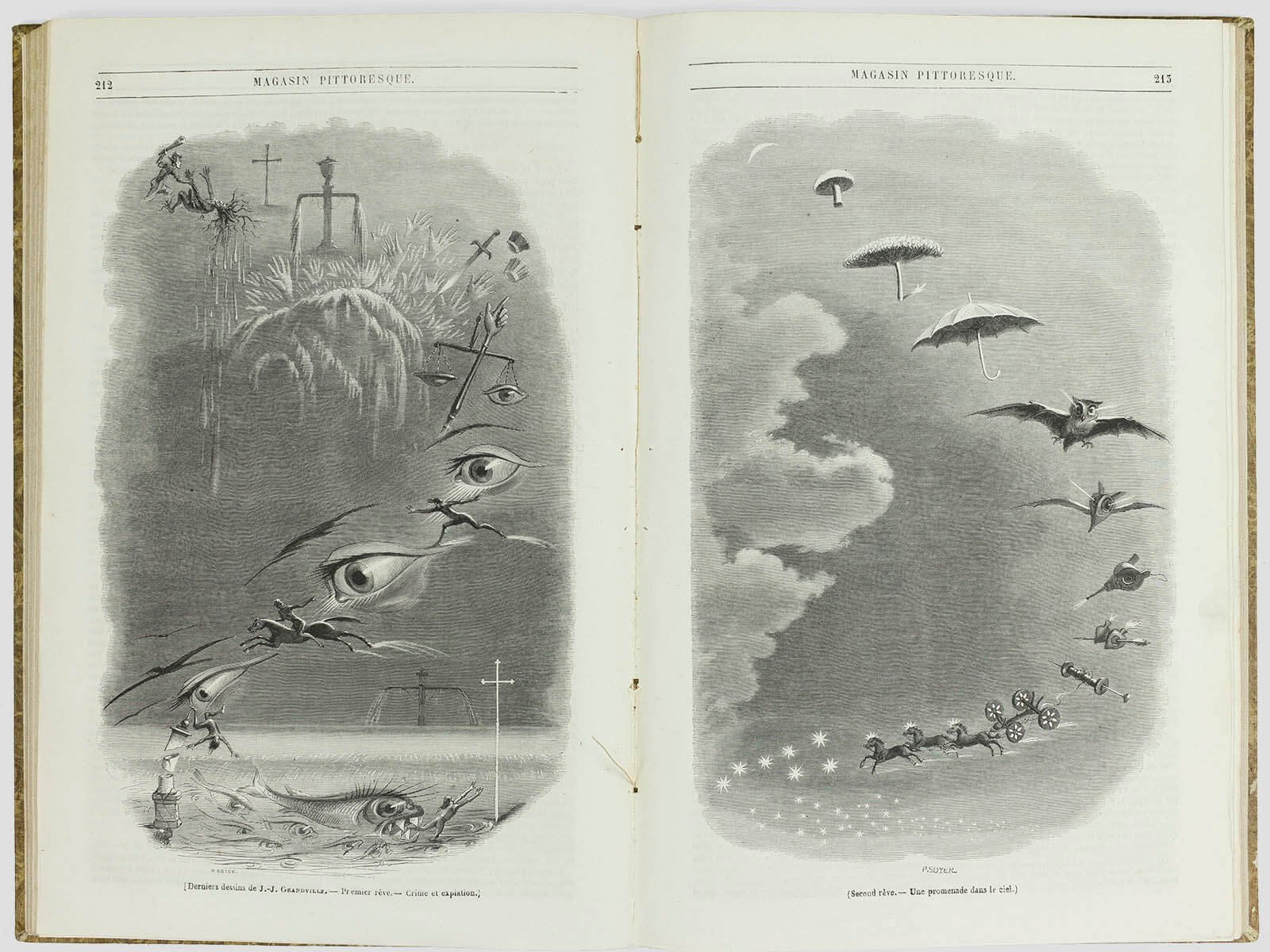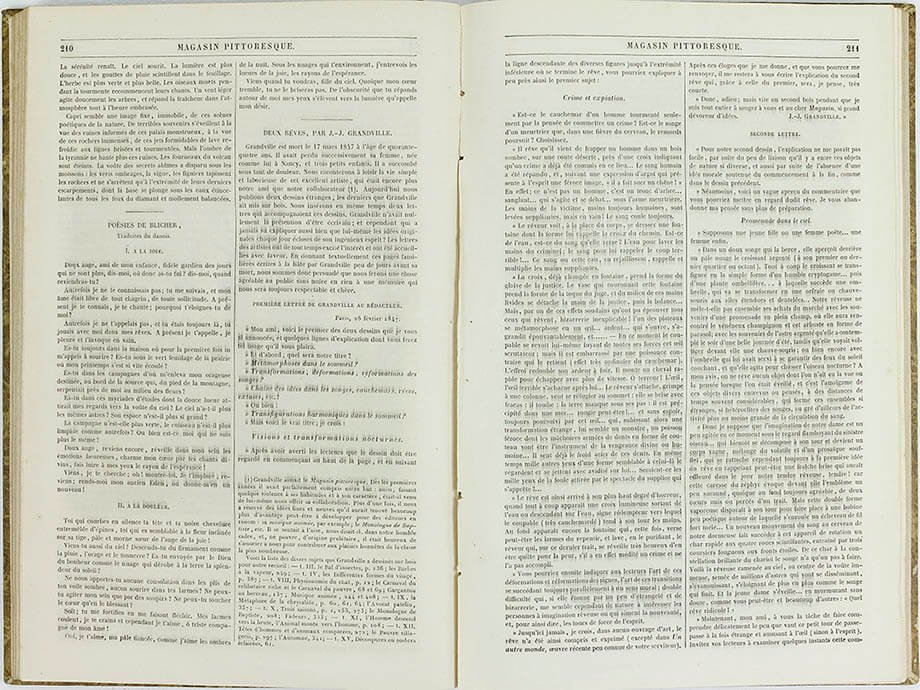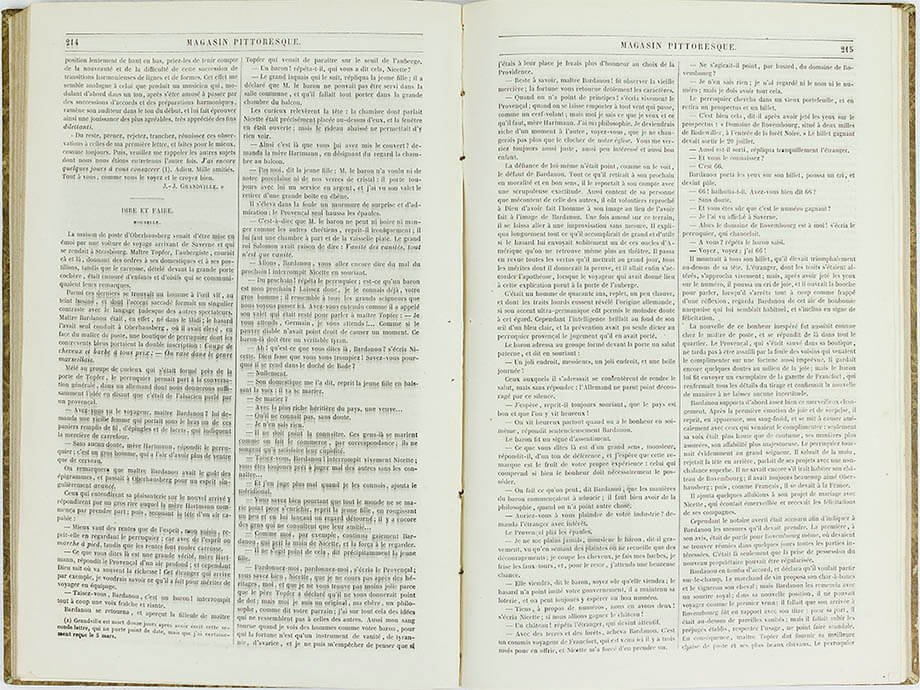TWO DREAMS, BY J.-J. GRANDVILLE
Published in Le Magasin Pittoresque. Volume XV. – July 1847. Pages 210 to 214.

(1) Grandville loved le Magasin pittoresque. From the very first years, he had perfectly understood our aim; so, doing some violence to his habits and character, he had come of his own accord to offer us his collaboration. More than once, he reserved for us fine and new ideas that he would perhaps have found much more advantageous to develop for renowned publishers: his animated music, for example; the Monologue de Baptiste, etc. He felt at ease, he told us, in our humble surroundings, and, born poor, of proletarian origin, he was happy to join us in contributing to the honest pleasures of the most numerous class.
Here is the list of the various subjects that Grandville drew on wood for our collection: – t. III. le Bal d’insectes, p. 136 ; les Barbes à la vapeur, 249 ; – t. IV, les Différentes formes du visage, p. 387 ; – t. VIII, Physionomie du chat, p. 12 ; le Carnaval du célibataire riche and le Carnaval du pauvre, 68 and 69 ; Gargantua au berceau, 137 ; Musique animée, 244 et 408 ; – t. IX. la Métaphore de la chrysalide, p. 60, 61, 64 ; l’Avocat patelin, 357 ; – t. X, Trois saisons, p. 1, 153, 273 ; le Monologue de Baptiste, 208 ; Fadeurs, 343 ; – t. XI, l’Homme descend vers la brute, l’Animal monte vers l’homme, p. 108 ; – t. XII, Têtes d’hommes et d’animaux comparées, 272 ; le Pauvre villageois, p. 297 ; l’Automne, 341 ; – t. XV, Découpures ou ombres éclairées, 61.

FIRST LETTER FROM GRANDVILLE TO THE EDITOR.
Paris, 26th February 1847.
« My friend, here is the first of the two drawings I have announced to you, and a few lines of explanation which you may make use of as you please.
» And first of all, what will our title be?
» Metamorphoses in sleep?
» Transformations, deformations, reformations of dreams?
» Chain of ideas in dreams, nightmares, laughter, ecstasies, etc.?
» Or:
» Harmonic transfigurations in sleep?
» But here is the real title, I believe:
Nocturnal visions and transformations.
» After warning readers that the drawing should be viewed beginning at the top of the page, and following the descending line of the various figures to the bottom where the dream ends, you might explain the first subject roughly as follows:
Crime and Atonement.
» Is it the nightmare of a man tormented only by the thought of committing a crime? Is it the dream of a murderer whom, in a fever of the brain, remorse pursues? Choose.
» He dreams that he has just struck a man in a dark wood, on a deserted road, near a cross indicating that a crime has already been committed in that place… Human blood has been spilled, and, according to a slang expression which presents a ferocious image to the mind, “he has made an oak tree sweat! Indeed; it is not a man, it is a tree trunk… bloody… shaking and struggling… under the murderous weapon. The victim’s hands, still human hands, are raised in supplication, but in vain! The blood still flows.
» The dreamer sees, in place of the body, a rising fountain whose shape reminds him of the cross on the road. Is it water or blood that it pours? Water to wash the hands of the criminal; blood to remind him of the terrible blow!… This blood or this water, by gushing out, reminds and multiplies the supplicating hands.
» The cross, already changed into a fountain, takes the form of the sword of justice. The vase which crowned this fountain takes the form of the judge’s hat, and from the midst of these livid hands the hand of justice stands out, then the scale… But, by one of those sudden effects which all those who dream may have experienced, an inexplicable oddity! one of the plates is metamorphosed into an eye… burning… which opens up, enlarges dreadfully, and… … – At this moment, the culprit sees himself fleeing with all his strength from this scrutinizing eye; but he is embarrassed by an opposing power that holds him back (a very ordinary effect of nightmares). Dread redoubles his eagerness to flee. He rides a fast horse to escape with greater speed. O terror! The eye, the terrible eye goes after him… The dreamer attaches himself, climbs a column, wants to take refuge at the top; it shatters with a crash; he falls; the earth is missing under his feet: he is precipitated into a sea… reddened perhaps! … and without hope, always pursued by this eye… which, undergoing a strange transformation, seems to him a monster, a ferocious fish whose armed jaws of knife-shaped teeth are going to be the instrument of divine or human vengeance… He already feels the cold steel of these teeth. At the same time, a thousand other eyes of a shape similar to that one look at him and throw themselves greedily on him… Could these be the thousand eyes of the crowd attracted by the spectacle of the torment which is about to come?…
» The dream has thus reached its highest degree of horror, when all of a sudden a luminous cross appears, emerging from the water or descending onto the water, a redemptive sign towards which the culprit (very nightmared) on turn tend his hands. In the background still appears the fountain which, this time, perhaps sheds the tears of repentance, and washes, while purifying him, the dreamer who, on this last stroke, wakes up very happy to be free from fear, if he has in fact meditated a crime and has not accomplished it.
» You could then indicate to the readers the art of these deformations and reformations of signs, the art of these transitions always following one another in parallel to a moral sense; a double difficulty which, if it astonishes by a little strangeness and bizarreness, seems to me nevertheless of such a nature as to interest people with a dreamy imagination or who love novelty, and, so to speak, les tours de force of the mind.
» Never before, I believe, in any work of art has the dream been understood and expressed in this way (except in Un autre monde, a little-known recent work by yours truly). After these eulogies, which I give myself, and which you can send back to me, it will remain for me to write you the explanation of the second dream, which, thanks to that of the first, will be, I think, very short.
» So, farewell; but quickly a second wood while I am all thinking of you and the dear Magasin, so great a devourer of ideas.
J.-J. GRANDVILLE. »

SECOND LETTER.
« For our second drawing, the explanation does not seem easy to me, owing to the lack of connection between these objects of such a diverse nature, and also owing to the absence of a sustained moral idea from beginning to end, as in the previous drawing.
» Nevertheless, here is a vague outline of the commentary that you could put next to the said dream. I leave my thoughts to you without further preparation.
A walk in the sky.
» Let us suppose a young girl or a woman poet… a woman at last.
» In a sweet dream that lulls her to sleep, she sees behind a pale cloud the silver crescent (at its first or last quarter or octant). Suddenly, the crescent is transfigured into the simple form of a humble cryptogam… then of an umbelliferous plant… followed by an umbrella, which is transformed into a goshawk or a bat with its wings spread and toothed… Does not our dreamer mingle together her market shopping with memories of a walk in the country, where she came across the poisonous mushroom and this umbrella-shaped shrub; with memories of the silver star she contemplated in the evening of a beautiful summer day, while she saw a bat flying in front of her; or again with the umbrella she used to protect herself from the fires of the setting sun, and which she waved to chase away the nocturnal bird? In my opinion, one does not dream of any object of which one has not seen or thought of while awake, and it is the amalgam of these various objects glimpsed or thought of, often at considerable distances of time, which forms these so strange, so heterogeneous sets of dreams, depending moreover on the greater or lesser activity of the blood-circulation.
» So I suppose that our lady’s imagination is a little agitated at this moment under the flamboyant gaze of the sinister bird… which soon decomposes in its turn and becomes a vague body, a mixture of the volatile and a prosaic bellows, which is however always linked to the first idea of the dream by recalling perhaps a fresh breeze that would have touched in the day our tender dreamer, tender! For this caress of the zephyr evokes before her the somewhat outdated, though still pleasant, emblem of two hearts joined or shot through. But this double vaporous form disappears in its turn to give way to an unpoetic spool around which is wound a skein of intertwined strong thread… A new movement of the blood in the brain of our sleeper makes this rotating device be succeeded by a fast chariot with four glittering wheels, driven by three fiery steeds with starry foreheads. From this chariot to the brilliant constellation of the chariot the dream has only one step to take. Here is the dreamer brought back to the sky, to the center of the immense vault, sown with millions of stars that are scattering, fading, and moving further and further away like the dream that ends. And the young lady wakes up… no doubt murmuring, like you perhaps and many others: « What a ridiculous dream! »
» Now, my friend, it is up to you to delicately convey the little worth of this strange and amusing little trick to the eye (if not to the mind). Invite your readers to examine this composition for a few moments slowly from top to bottom, asking them to take into account the novelty and the difficulty of this succession of harmonious transitions of lines and forms. This effect seems to me analogous to that produced by a musician who, first modulating in one key, after having amused himself by going through successions of chords and harmonic preparations, brings his listener back to the key of the beginning, and thus makes one experience a most agreeable enjoyment, much appreciated by the fine dilettanti.
» For the rest, take, reject, decide, combine these observations with those of my first letter, and do the best you can, as always. Then please remind me of the other topics we discussed last time. I still have a few days to dedicate to you (2). Farewell. A thousand greetings. All yours, as you can see and believe.
J.-J. GRANDVILLE. »
(2) Grandville died twelve days after writing this second letter, which bears no date, but which I certainly received on March 5.